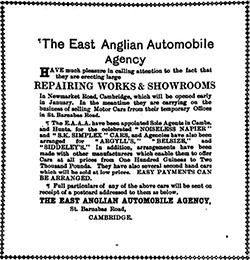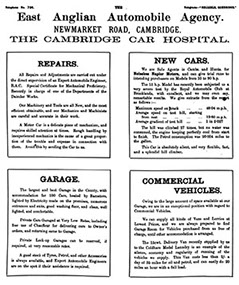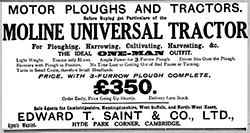The CO - Commanding the Cambs
There are many factors that influenced the efficiency, effectiveness and personality of an infantry battalion during the War. Made up of over a thousand men when at full strength, all ranks have some varying degree of impact on the overall nature of the unit. However, as one would expect, there is a disproportionate amount of influence and responsibility for one key individual – the Commanding Officer.
By the winter of 1917 the 1/1st Battalion, Cambridgeshire Regiment had, on paper, had nine commanding officers since the war began. Undoubtedly the most successful of these, Lt Col “Ted” Riddell, had commanded the Battalion through the bitter fighting on the Somme, the cold winter in the Ypres Salient and then the epic Third Battle of Ypres. After the successful attack and capture of Joist Redoubt on Tower Hamlets Ridge, Riddell was promoted and was ordered to leave the Cambs to command the 149th Brigade. The tricky task of filling the void left by Riddell’s departure from the Cambs was given to the 32 year-old Edward Saint
Lt Col Edward Twelftree Saint DSO
Born in Cambridge in the winter of 1884, he was the eldest son of William and Matilda Saint. His father, William, ran a successful building firm and in later life became involved in local politics, holding various positions on council committees and elected councillor for the Petersfield Ward. The young Edward received a good education, attending the Ivel Bury School and the Perse School from the age of seven.
After completing his education, Edward joined his father’s building firm and a short time later, at the age of 15, enlisted in C Company, 3rd Volunteer Battalion, Suffolk Regiment. Under the watchful eyes of the company commander, Major Oliver Papworth, a local solicitor, Edward proved to be an enthusiastic Volunteer, even attempting, unsuccessfully, due to his age, to join the Service Company that went to South Africa during the Boer War. In January 1906 his potential was recognised and he was commissioned as a 2nd Lieutenant, and six months later he was promoted to Lieutenant.
In 1907, after gaining much valuable experience while working for his father and from serving in the Volunteers, Edward branched out from the family business and established himself as an automotive engineer and retailer, operating under the name The East Anglian Automobile Agency. The firm proved to be highly successful and soon a purpose-built garage and showroom were built on Newmarket Road, with adverts claiming it to be “The Cambridge Car Hospital”. In his spare time, Edward continued to be a dedicated officer in the Volunteers. In 1908 the Volunteer Battalions were disbanded and Lt Saint was among those who enlisted immediately in the newly created Territorial Force battalion that, in 1909, was named the Cambridgeshire Regiment.
Edward’s life continued to develop and in April 1909 he married his fiancée, Ida Elsie Muirhead at a rather grand wedding at St Barnabas’ Church, Cambridge. The couple moved into a house on St Barnabas Road and had two children, Joan (born March 1910), and Hugh (born May 1912). Edward’s business continued to grow and in 1910 he took over a rival car sales business and merged it with his own, forming Edward T. Saint and Co. Ltd, based on Hyde Park Corner (Regent Street), Cambridge. The new larger firm and prominent location proved to be a shrewd move and they were able to secure sole selling rights in the region for several key automotive manufacturers.
Alongside his service in the Territorial Force, Edward had a keen interest in shooting and was an excellent shot. As an active member of several small bore rifle clubs he regularly took part in numerous county competitions. These local shooting clubs were a popular hobby for many and prize matches were always highly competitive. Numerous other stalwarts of the Volunteers and later, Territorials, such as the Pulls, Utteridge, Bowyer and even Saint’s mentor, Major Papworth, were also very active in this circle and these men dominated many of the competitions. The fact that the majority of these named men also happened to be serving in C Company meant that most of the inter-company competitions were also won by Papworth’s Company!
In 1911, after nearly 35 years service, Major Papworth retired and command of C Company was passed to his protégé, Edward Saint. In a clear demonstration of his dedication and eagerness Saint also volunteered to command the Special Service Section. This was a small group of volunteers from across the entire battalion who had all signed up for Imperial Service, meaning they were eligible to serve overseas - the origins of this group can be traced back to the Volunteers who signed up to go to South Africa during the Boer War. It was a small select group of some of the keenest Territorials and the Imperial Service badge they wore was seen as a mark of distinction.
Despite his busy life and numerous commitments to family, business and the Territorials, Edward regularly attended social events and often gave lectures and lanternslide presentations on the Territorials. As successful local employers, both Edward and his father, William, played an important part in convincing other local businesses to allow their staff to serve in the TF, with much of this work being done through the County Territorial Force Association.
During the 1914 summer camp at Ashridge Park, with war in Europe an ever-growing likelihood, Saint and his Special Service Section were mobilised. As the rest of the Battalion finished the camp and returned home to Cambridgeshire, the Special Service Section was tasked with guarding a wireless station near Ipswich. Within days war was declared and the rest of the Cambridgeshires were mobilised. Several weeks later it was decided to turn the Battalion into an Imperial Service Battalion and the majority of the pre-war Territorials volunteered, waiving their right to remain in the UK. This rendered the need for the Special Service Section obsolete and the men were reintegrated back into the 1st Battalion.
During the busy and rather frustrating first six months of the War, the Battalion experimented with several new, unofficial, pieces of technology. One of these was at least one modified Napier car, believed to have been modified and donated by Saint’s own company. With the addition of some armour plate and filled with heavily armed Cambridgeshires, the car became the Battalion’s “rapid” response during many of the frequent invasion scares.
In the first weeks of 1915 things took a rather more serious turn and the final preparations for the Battalion leaving for the Western Front were made. As part of this the Companies were restructured and enlarged by merging two together. Saint’s C Company merged with D Company to form the new larger B Company, with the now Major Saint remaining as company commander. Arriving in France on the 15th February 1915, B Company were among the first of the Battalion to experience the front line and suffered the Battalion’s first casualty, Cpl Noble Dewey, on 4th March 1915.
Saint’s command of B Company lasted until August 1915, during which time he was Mentioned in Dispatches for his gallantry during the fighting at St Eloi. In August, suffering from fatigue, he was put on sick leave and returned to England where he spent some time with the 3/1st Battalion. He returned to the 1/1st Battalion in mid-October and given the position of Second in Command. In late December requests were made by the County Territorial Association for Saint to be given command of the recently formed 4/1st Battalion and in January 1916 Saint returned to England to take up his new post.
After 10 months leading the 4/1st Battalion and with the rank of T/Lt Col, Saint was keen to return to the Western Front. His request was finally approved and in late November 1916 he took command of the 16th (Bantam) Battalion, Cheshire Regt, who were in the line around Arras. On his arrival, Saint found a battalion that was in great need of training, rest and fresh drafts of replacements. The next three months were spent training and reshaping the Battalion, but these efforts were frustratingly hampered by substandard drafts of replacements and numerous men were rejected or transferred to other units.
In late February 1917, Saint and the 16th Cheshires were finally moved back to the front and their brigade took over a section of the line from the French east of Amiens. Several days later, on 1st March, the 16th Cheshires took over the front line to the east of the village of Chilly; it was to prove to be a less than auspicious start for Saint’s rebuilt battalion. The first 24 hours in the front line passed relatively quietly, but during the evening of the 2nd March the Germans opened up a heavy bombardment and a small raiding party entered the Cheshires’ positions. Luckily the raiders were intercepted and after some hand-to-hand fighting were evicted.
Before dawn on the 3rd March another heavy bombardment crashed down and a second, much larger, raid crept across no man’s land. Around 50 German raiders broke into the Cheshires’ positions and took over a section of the line, including some if the trenches manned by 19th Durham Light Infantry to the left. Fierce fighting, especially with bomb and Lewis gun, raged for 15 minutes before the raiders finally fell back under the cover of a heavy smoke screen. They left behind three dead and one mortally wounded man, along with some equipment. However the cost to the Cheshires was high with 25 men killed or wounded and a further 19 men missing, many of these later confirmed as having been taken prisoner. Alongside their haul of prisoners the raiders also took a considerable amount of captured equipment back with them, including both a Vickers and Lewis machine gun.
The reasons that the raid achieved such results, be it German planning, luck or fault with the defenders, can now only be speculated over. The official report, signed by the Divisional Commander, ended by stating: “an inquiry is being held into the circumstances”. One week later Saint relinquished his command and was posted to run the Divisional School at Boves. The rumours of this soon reached the 1/1st Cambs, with one officer writing home: I don’t know whether he (Saint) got fired or not! He seems very much the same and full of energy. Clayton, later writing in the regimental history noted: … he uncomplainingly took upon his shoulders the blame for other people’s shortcomings.
After only just over two weeks at Boves, Saint returned to the 1/1st Cambs, reverting to Major and taking up the position of Second in Command. In early July, as the Battalion readied for the summer offensive, Saint was ordered back to England where he attended a senior officers course at Aldershot. By coincidence this posting saved Saint from much of the 3rd Battle of Ypres and, when Riddell was promoted in the days following the Joist Redoubt attack, meant he was in the ideal situation to return to the Battalion and take up command.
Saint arrived back to a very different Battalion to the one he had left several months earlier. Losses had been very heavy, including his brother-in-law, Lt Alexander Muirhead. His return and promotion to commanding officer was met with a silent mixed reaction by the men. Writing about it in the regimental history, Clayton stated:
Saint return to assume command in Riddell’s place was a happy coincidence. He would have been the first to admit that he had missed much valuable experience during the past few months, but he had a strong personality, tactical skill to a marked degree, and was fresh and not clogged mentally by the “sea of mud” in which those of us who had survived had been wallowing for so long.
After over seventeen years service and as a prominent Cambridge businessman, Saint was well known to both officers and men of the Regiment. The “strong personality” mentioned by Clayton was seen by some as a positive trait and left others quietly regarding him as a bully and difficult to live with. For Saint, finally being given command of his beloved Cambridgeshires must have felt like a mixed blessing. He took over command of a battalion that had achieved amazing results under their previous CO, Riddell - an officer who was openly adored and greatly missed by all ranks. He also took command of a battalion that, as with the 16th Cheshires, was weary, understrength and in need of rest and refit.
The much-needed rest after the Battalion’s epic capture and consolidation of Joist Redoubt was cut short and a most trying time, both in and out of the front line, ensued. Saint, however settled into his new command well, never shying away from a challenge even if his style and method was not always popular. By the early spring of 1918 the Battalion was functioning efficiently under his leadership – the next few weeks were to prove to be the most chaotic and intense of not only his time in command but for the Battalion’s entire war.
On 21st March 1918, the German Spring Offensive was launched and as the front line collapsed and fell back the Cambridgeshires, like many other battalions, were thrown into a series of bitter-fought rearguard actions. As casualties mounted and men were muddled up in the chaos, the conventional brigade and battalion structures ceased to exist. Saint proved to be an adaptable and strong leader, taking command of multiple groups of stragglers as well as his own Cambridgeshires. One week after the German offensive began and following the loss of the 118th Brigade’s CO (Brig Gen Bellingham, who was captured on the 28th March), Saint assumed command of the survivors of both the 116th and 118th Brigades. On 1st April, the exhausted and shattered division was relieved and finally moved back for a rest.
Saint’s leadership and skill during this time was recognised by the award of the Distinguished Service Order, the citation reading:
For gallantry throughout ten days operations, during the first seven of which he showed marked initiative in organising lines of defence, especially in front of a town, where he held up the enemy advance, enabling the guns to be withdrawn. When the officer commanding another battalion became a casualty, he assumed command of both battalions. Later, when the officer commanding brigade became a casualty, he took command of the brigade, organised a counter attack at a critical time, reoccupying the line. He kept the men splendidly together when nearly all the officers and non-commissioned officers had become casualties.
As the situation at the front stabilised, Saint returned to England for a rest and spent several weeks at the Le Strange Arms Hotel in Hunstanton with his family, returning to France in late May. As the tide of the war began to shift once again and preparations were made for the Allied counteroffensive, Saint filled in as Brigade CO for several brief spells. After his successful and gallant command during the German Spring Offensive his career seemed to be on track, with further promotion a likely future prospect. For now, his focus remained on his Cambridgeshires and the hard fighting of what was to become known as the Hundred Days Offensive.
On August 8th, 1918 the great offensive began and after several weeks of heavy fighting the Cambridgeshires were to the east of Mametz. On 27th August, as the line advanced, they took up positions along the road north of Maricourt with the chalk slope of the Matlz Horn Ridge looming to their front. The fluid nature of the advance meant that positions were often improvised and were on occasions far from ideal.
Knowing that their stay in this area would only be brief, Saint situated Battalion HQ in what he felt was the best available shelter - a brickyard on the left of Cambs’ position, with some abandoned German defences, including several crude shelters. These shelters were around eight foot deep, with wooden posts holding up lengths of railway track, over which sheets of corrugated tin had been placed. They were by no means as safe as a proper dugout and both Clayton (Second in Command) and Jerry Walker (Adjutant) noted that they both felt uneasy about their use, however there were no other suitable locations or time to create one.
The Cambridgeshires attacked at dawn, pushing up the ridge and taking the positions at the top. After a day of fighting and consolidating the captured positions, the men readied to be relieved by the Norfolks. In Battalion HQ the men were packing up and the Norfolk’s Signalling Officer arrived to arrange the hand over. In the cruellest of blows one of the very last German artillery shells fired that day crashed straight through the tin roof of the Battalion HQ, exploding under the table that many of the occupants were crowded around.
The blast instantly killed Lt Harry Driver MC (Cambs Signalling Officer) and Lt Geoffrey Madison (Norfolks Signalling Officer) along with several runners and signallers. Lt Col Edward Saint was gravely wounded, while Capt Jerry Walker MC and several other men were slightly wounded. As the dust settled Walker, although badly shaken, took control of the situation as best he could. Even while being treated by the Battalion Medical Officer, Lt Clinton, Saint kept briefing Walker to make sure all orders were known. His wounds were severe, with his left arm being torn away by the blast. He was evacuated back to the 53rd Casualty Clearing Station but sadly succumbed to his wounds the following day.
News of Saint’s death was a shock to all, as one of the few remaining pre-war officers he had come through so much unscathed already. At the time of his death he was only 33, leaving behind his widow and two young children, aged seven and five. With the rank of Lt Colonel, he is the highest-ranked officer killed during the Regiment’s service in WW1 and is remembered on numerous war memorials, including the Old Perseans Memorial at the Perse School. He is buried, close to the site of the CCS where he died, at what is now known as Daours Communal Cemetery. The epitaph on his grave, reflecting the dedicated service to both regiment and country that dominated so much of his life, reads DULCE ET DECORUM EST PRO PATRIA MORI.
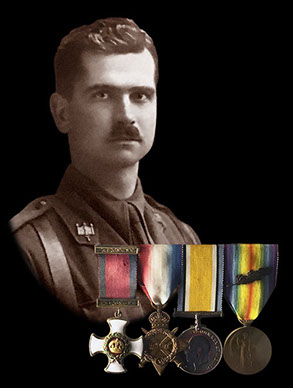
Lt Col Edward T. Saint DSO.
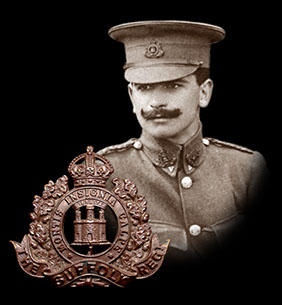
A freshly commissioned 2nd Lt Saint in 1906.
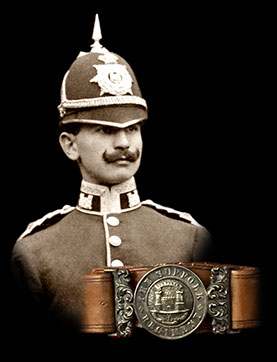
2nd Lt Saint wearing a Home Service helmet.

Edward at a 3rd VB Officers' Mess dinner.
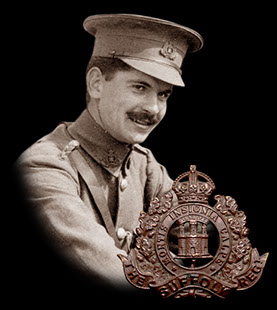
Lt Saint while at annual camp in 1908.
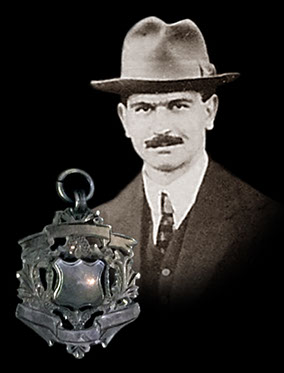
Edward while at a shooting competition.

The destroyed Bn HQ at the brickyard.

This site went live on the 14th February 2015 to mark 100 years since the 1/1st Cambs went off to war.
WE WILL REMEMBER THEM
Email us: cambsregt@gmail.com
Copyright 2015, 2016, 2017, 2018, 2019 by Felix Jackson. The information and images on this site should not be reproduced without prior permission.
